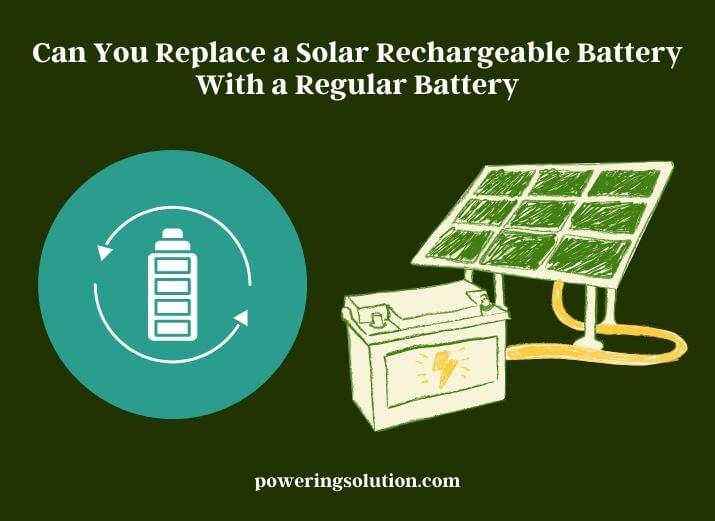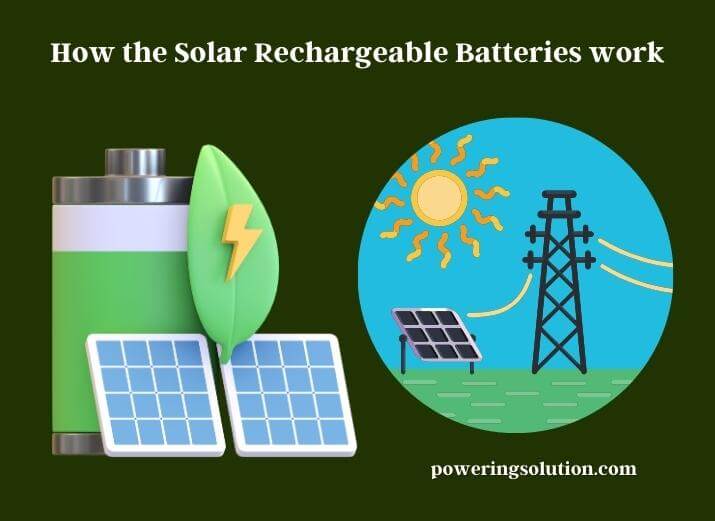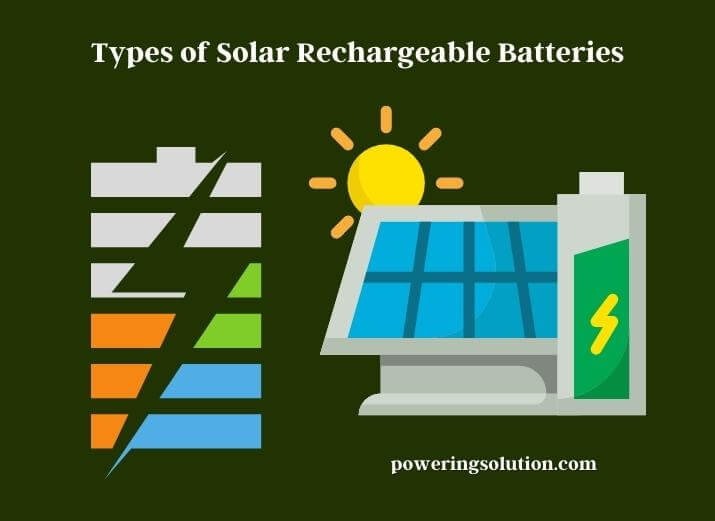Solar rechargeable batteries are a popular and eco-friendly way to power various devices. These batteries use solar energy to recharge, making them ideal for outdoor use and remote locations where electricity may not be available. However, some people may wonder if they can replace solar rechargeable batteries with regular batteries.

While it is possible to do so, it may not be the best idea. In this article, we will discuss the differences between solar rechargeable and regular batteries, the factors to consider before making the switch, and the consequences of replacing a solar rechargeable battery with a regular battery. We will also provide alternatives to replacement that can help extend the lifespan of your solar rechargeable battery.
How the Solar Rechargeable Batteries work?
Solar rechargeable batteries use photovoltaic cells to convert solar energy into electrical energy. The cells in the battery absorb sunlight and convert it into electricity, which is stored in the battery’s cells. The stored energy can then be used to power various devices, such as flashlights, remote controls, and outdoor lighting. The batteries are designed to be recharged by exposure to sunlight, which makes them an ideal solution for outdoor use, remote locations, and emergency situations.
The solar rechargeable battery typically consists of a positive electrode (anode), a negative electrode (cathode), and an electrolyte. When sunlight shines on the solar cell, the electrons in the anode absorb the energy and become excited. The electrons then flow to the cathode through an external circuit, producing electrical energy. At the same time, the electrolyte facilitates the movement of ions between the anode and cathode, which maintains the battery’s electrical charge. This process is known as the photovoltaic effect, and it is what makes solar rechargeable batteries unique.

In contrast, regular batteries are designed to store chemical energy and convert it into electrical energy. They contain chemical substances that undergo chemical reactions to produce electrical energy. The chemical reactions can only occur for a limited time, and once the chemical energy is used up, the battery stops working. Regular batteries cannot be recharged and must be disposed of once they are used up.
Types of Solar Rechargeable Batteries
There are several types of solar rechargeable batteries available on the market, each with its own advantages and disadvantages. The most common types include:
Nickel Cadmium (Ni-Cd) Batteries
Nickel Cadmium (Ni-Cd) batteries were one of the first rechargeable batteries to be used in solar-powered devices. They are known for their long cycle life, meaning they can be recharged and discharged many times. They are also resistant to extreme temperatures, making them ideal for outdoor use. However, they have a low energy density, which means they cannot hold as much energy as other types of batteries, and they contain toxic materials, which can be harmful to the environment.
Nickel Metal Hydride (Ni-MH) Batteries
Nickel Metal Hydride (Ni-MH) batteries are an improvement over Ni-Cd batteries. They have a higher energy density, meaning they can hold more energy than Ni-Cd batteries. They are also more environmentally friendly because they do not contain toxic materials. However, they have a shorter cycle life than Ni-Cd batteries and are more sensitive to extreme temperatures.
Lithium-Ion (Li-ion) Batteries
Lithium-Ion (Li-ion) batteries are the most advanced type of solar rechargeable batteries. They have a high energy density, meaning they can hold more energy than other types of batteries. They also have a long cycle life and are more environmentally friendly than Ni-Cd batteries. However, they are more expensive than other types of batteries, and they are sensitive to extreme temperatures.

Lead Acid Batteries
Lead Acid batteries are not as commonly used in solar-powered devices as other types of batteries. They have a low energy density and a short cycle life, but they are relatively inexpensive and can handle extreme temperatures. They are commonly used in larger solar systems, such as those used to power homes and businesses. They are heavy and require regular maintenance.
Advantages and disadvantages of Solar Rechargeable Batteries
Solar rechargeable batteries have several advantages and disadvantages when compared to regular batteries.
Advantages:
- They are eco-friendly and do not produce harmful emissions.
- They can be recharged using sunlight, making them a cost-effective solution.
- They are portable and can be used in remote locations.
- They have a long cycle life and can be recharged and discharged many times.
- They are resistant to extreme temperatures, making them ideal for outdoor use.
- They come in various sizes and capacities, making them suitable for different devices and applications.
- They can be used in conjunction with solar panels to create a complete solar power system.
Disadvantages:
- They are more expensive than regular batteries.
- They require exposure to sunlight to be recharged, which can be a disadvantage in certain weather conditions or locations.
- They may have a lower energy density compared to regular batteries.
- They may have a shorter lifespan compared to regular batteries.
- They may require specialized equipment to charge them, which can be an additional cost.
It is important to consider these advantages and disadvantages when choosing a solar rechargeable battery for your needs. If you need a portable and eco-friendly solution, a solar rechargeable battery may be the best choice. If you need a high-energy density or a longer lifespan, a regular battery may be a better option.
Understanding Solar Rechargeable Batteries
Solar rechargeable batteries are a type of battery that can be recharged using solar power. They are commonly used in solar-powered devices such as solar lights, solar panels, and other devices that require a battery as a power source. These batteries are designed to be recharged multiple times, making them a cost-effective and eco-friendly solution.
The concept of solar rechargeable batteries is relatively simple. The battery contains a solar panel that converts sunlight into energy, which is stored in the battery. This energy can then be used to power various devices, making them ideal for remote locations or for outdoor use.
One of the main advantages of solar rechargeable batteries is that they are eco-friendly. Unlike regular batteries, they do not produce harmful emissions, making them a sustainable alternative. They also reduce the need for disposable batteries, which can be expensive and harmful to the environment.
Another advantage of solar rechargeable batteries is their portability. They can be used in remote locations where electricity is not available or in areas where power outages are common. They are also ideal for outdoor use, as they are resistant to extreme temperatures and can withstand harsh weather conditions.
There are several types of solar rechargeable batteries available on the market, including Nickel Cadmium (Ni-Cd) batteries, Nickel Metal Hydride (Ni-MH) batteries, Lithium-Ion (Li-ion) batteries, and Lead Acid batteries. Each type has its own advantages and disadvantages, and it is important to choose the right type of battery for your needs.
When using solar rechargeable batteries, it is important to ensure that they are charged properly. Overcharging or undercharging can reduce the battery’s lifespan and affect its performance. It is also important to store the batteries in a cool, dry place when not in use to prevent damage.
Solar rechargeable batteries are a sustainable and cost-effective solution for powering various devices. By understanding how they work and the different types available, you can choose the right battery for your needs and make a positive impact on the environment.
Differences Between Solar Rechargeable and Regular Batteries
When choosing a battery for your device, it is important to consider the differences between solar rechargeable batteries and regular batteries. The following table outlines some of the key differences between these two types of batteries:
| Points | Solar Rechargeable Batteries | Regular Batteries |
| Power source | Solar energy | Chemical reaction |
| Rechargeability | Rechargeable multiple times | Disposable |
| Lifespan | Can last several years | Varies depending on the type |
| Environmental impact | Eco-friendly, no harmful emissions | Harmful to the environment when disposed of improperly |
| Cost | More expensive upfront, but cost-effective in the long run | Less expensive upfront, but may be more costly over time |
| Availability | May not be available everywhere | Widely available |
| Charging time | Longer charging time | Faster charging time |
It is important to consider these differences when choosing a battery for your device. Solar rechargeable batteries may be a better choice for those who want a sustainable and cost-effective solution, while regular batteries may be a better option for those who need a high-energy density or longer lifespan. Ultimately, the choice depends on your individual needs and preferences.
Can You Replace a Solar Rechargeable Battery with a Regular Battery?
One common question that arises when it comes to solar rechargeable batteries is whether they can be replaced with regular batteries. The answer to this question is not straightforward, as it depends on the device and the battery requirements.
Solar rechargeable batteries are specifically designed to be used with devices that are compatible with them. These devices typically have a built-in charging system that is optimized for solar rechargeable batteries. If you were to replace a solar rechargeable battery with a regular battery, the device may not function properly or may not be able to charge the battery.
Furthermore, regular batteries are not designed to be recharged and may even be damaged if attempts are made to recharge them. This can lead to a shorter lifespan for the battery and may even damage the device.
It is important to note that some devices may be compatible with both solar rechargeable batteries and regular batteries. In these cases, it may be possible to replace the solar rechargeable battery with a regular battery. It is important to check the device specifications and requirements before making any substitutions.
Whether or not you can replace a solar rechargeable battery with a regular battery depends on the device and its specifications. It is important to follow the manufacturer’s recommendations and guidelines to ensure the proper functioning of the device and to avoid any potential damage to the device or battery.
In a Nutshell
Solar rechargeable batteries are a sustainable and cost-effective option for powering your devices. They work by converting solar energy into electrical energy, which can then be used to power your devices. There are several types of solar rechargeable batteries available, each with its own advantages and disadvantages.
When compared to regular batteries, solar rechargeable batteries offer several benefits, including eco-friendliness, multiple recharging options, and a longer lifespan. However, they may be more expensive upfront and may not be compatible with all devices.
It is important to consider the specific requirements of your device when choosing a battery, as well as the environmental impact and cost-effectiveness of the battery. Whether or not you can replace a solar rechargeable battery with a regular battery depends on the device and its specifications, and it is important to follow the manufacturer’s recommendations to avoid any potential damage to the device or battery.
Solar rechargeable batteries offer a sustainable and efficient way to power your devices, and they are worth considering for their long-term benefits.
